Dynamic Compensation of a Fluxgate Magnetometer Based on a Hybrid Optimizing Algorithm
Abstract
Featured Application
Abstract
1. Introduction
2. Materials and Methods
2.1. Construction of the Dynamic Compensator for the Fluxgate Magnetometer
2.1.1. System Identification for the Fluxgate Magnetometer
2.1.2. Principle and Modeling of Dynamic Compensation
2.2. GA-SA Hybrid Optimization Algorithm
- Initialization: the simulation process of biological evolution.
- 2.
- Calculation of the fitness function:
- 3.
- Determine whether convergence criteria are met:
- 4.
- Perform replication, crossover, and variation operations on individuals. Generate the next generation population.
- 5.
- Simulated annealing searches are performed on each individual of the population.
- Take the first individual A1 in the population as an example:
- (1)
- Generate individual new states: where y is a zero random number with a bilateral symmetric distribution, and UB and LB are the upper and lower bounds of the solution range. For the current difference equation coefficients, take −10 and 10, respectively.
- (2)
- If , accept the new state of the individual, namely, . Otherwise, deny updating the new state.
- (3)
- Determine whether the Metropolis criterion is met. If ‘Yes’, go to Step 6. Otherwise, repeat Step 5.
- 6.
- Annealing:
- 7.
- Repeat Step 2 and Step 3 until the algorithm convergence rules are met and the current result is outputted.
3. Simulation and Signal Test
3.1. Simulation Results and Discussion
3.1.1. Comparison of Compensation Effects of Different Order Dynamic Compensators
3.1.2. Comparison of Compensation Effects of the Optimization Algorithm
3.2. Standard Signal Test Results and Discussion
3.2.1. Verification of the Step Magnetic Field Compensation Effect
3.2.2. Verification of Different Frequency Sinusoidal Magnetic Field Compensation Effects
4. Experiment and Discussion
4.1. Experimental Equipment and System
4.2. Experiment Process
4.2.1. Calibration of the Geomagnetic Background Field
4.2.2. Geomagnetic Dynamic Measurement
4.3. Result and Discussion
5. Conclusions
Author Contributions
Funding
Institutional Review Board Statement
Informed Consent Statement
Data Availability Statement
Conflicts of Interest
References
- Chen, Z.; Liu, Z.; Zhang, Q.; Chen, D.; Pan, M.; Hu, J.; Xu, Y.; Wang, Z.; Wang, Z. An Improved Geomagnetic Navigation Method Based on Two-Component Gradient Weighting. IEEE Geosci. Remote Sens. Lett. 2022, 19, 3213779. [Google Scholar] [CrossRef]
- Liu, Z.; Pang, H.; Pan, M.; Wan, C. Calibration and Compensation of Geomagnetic Vector Measurement System and Improvement of Magnetic Anomaly Detection. IEEE Geosci. Remote Sens. Lett. 2016, 13, 2519026. [Google Scholar] [CrossRef]
- Du, A.M.; Zhang, Y.; Li, H.Y.; Qiao, D.H.; Yi, Z.; Zhang, T.L.; Ge, Y.S.; Luo, H.; Zhao, L.; Sun, S.Q.; et al. The Chinese mars rover fluxgate magnetometers. Space Sci. Rev. 2020, 216, 1–15. [Google Scholar] [CrossRef]
- Sheinker, A.; Frumkis, L.; Ginzburg, B.; Salomonski, N.; Kaplan, B.-Z. Magnetic Anomaly Detection Using a Three-Axis Magnetometer. IEEE Trans. Magn. 2009, 45, 160–167. [Google Scholar] [CrossRef]
- Liu, Z.; Zhang, Q.; Pan, M.; Shan, Q.; Geng, Y.; Guan, F.; Chen, D.; Tian, W. Distortion Magnetic Field Compensation of Geomagnetic Vector Measurement System Using a 3-D Helmholtz Coil. IEEE Geosci. Remote Sens. Lett. 2016, 14, 48–51. [Google Scholar] [CrossRef]
- Pang, H. Error Analysis and Calibration/Compensation Method of Portable Geomagnetic Vector Measurement System. Ph.D. Thesis, National University of Defense Technology, Changsha, China, 2015. [Google Scholar]
- Ninness, B.M. Stochastic and Deterministic Modeling. Ph.D. Thesis, Dept. of Electrical Engineering, University of Newcastle, Newcastle, Australia, 1993. [Google Scholar]
- Ljung, L. System Identification; Birkhäuser: Boston, MA, USA, 1998. [Google Scholar]
- Chen, S. Research on Performance Enhancement of Residence Time Difference Fluxgate Sensors Based on the Dynamic Hysteresis Model. Ph.D. Thesis, Jilin University, Changchun, China, 2019. [Google Scholar]
- Yu, H.; Feng, S.; Li-Hua, W. Synchronous correction of two three-axis magnetometers using FLANN. Sens. Actuators A Phys. 2012, 179, 312–318. [Google Scholar] [CrossRef]
- Crassidis, J.L.; Lai, K.L.; Harman, R.R. Real-Time Attitude-Independent Three-Axis Magnetometer Calibration. Am. Inst. Aeronaut. Astronaut. 2005, 28, 115–120. [Google Scholar] [CrossRef]
- Altintas, Y.; Park, S.S. Dynamic compensation of spindle-integrated force sensors. CIRP Ann. 2004, 53, 305–308. [Google Scholar] [CrossRef]
- Ralf, Z.; Rolf, I. Nonlinear time constant estimation and dynamic compensation of temperature sensors. Control. Eng. Pract. 2010, 18, 300–310. [Google Scholar]
- Yu, D.; Liu, F.; Lai, P.-Y.; Wu, A. Nonlinear Dynamic Compensation of Sensors Using Inverse-Model-Based Neural Network. IEEE Trans. Instrum. Meas. 2008, 57, 2364–2376. [Google Scholar] [CrossRef]
- Xin, L. Identification of Nonlinear Systems with non-Ideal Process Data. Ph.D. Thesis, Harbin Institute of Technology, Harbin, China, 2019. [Google Scholar]
- Marconato, A.; Hu, M.; Boni, A.; Petri, D. Dynamic Compensation of Nonlinear Sensors by a Learning-From-Examples Approach. IEEE Trans. Instrum. Meas. 2008, 57, 1689–1694. [Google Scholar] [CrossRef]
- Franklin, G.F.; Powell, J.D.; Emami-Naeini, A.; Powell, J.D. Feedback Control of Dynamic Systems; Prentice Hall: Upper Saddle River, NJ, USA, 2002. [Google Scholar]
- Oppenheim, A.V.; Willsky, A.S.; Nawab, S.H.; Ding, J.J. Signals and Systems; Prentice Hall: Upper Saddle River, NJ, USA, 1997. [Google Scholar]
- Wu, D.; Huang, S.; Zhao, W.; Xin, J. Infrared thermometer sensor dynamic error compensation using Hammerstein neural network. Sens. Actuators A Phys. 2009, 149, 152–158. [Google Scholar] [CrossRef]
- Pintelon, R.; Schoukens, J. System Identification: A Frequency Domain Approach; John Wiley & Sons: New York, NY, USA, 2012. [Google Scholar]
- Narendra, K.; Parthasarathy, K. Identification and control of dynamical systems using neural networks. IEEE Trans. Neural Netw. 1990, 1, 4–27. [Google Scholar] [CrossRef]
- Chongz, F.; Dey, X. Process Identification; Tsinghua University Publishing House Co., Ltd.: Beijing, China, 1988. [Google Scholar]
- Schoen, M.P.; Hoover, R.C.; Chinvorarat, S.; Schoen, G.M. System identification and robust controller design using genetic algorithms for flexible space structures. J. Dyn. Syst. Meas. Control. 2009, 131, 304–314. [Google Scholar] [CrossRef]
- Li, M.Q.; Kou, J.; Lin, D.; Li, S.Q. Basic Theory and applicAtion of Genetic Algorithm; The Publishing of Science: Beijing, China, 2002. [Google Scholar]
- Pang, F. The Principle of Simulated Annealing Algorithm and Its Application in Optimization Problems. Ph.D. Thesis, Jilin University, Changchun, China, 2006. [Google Scholar]
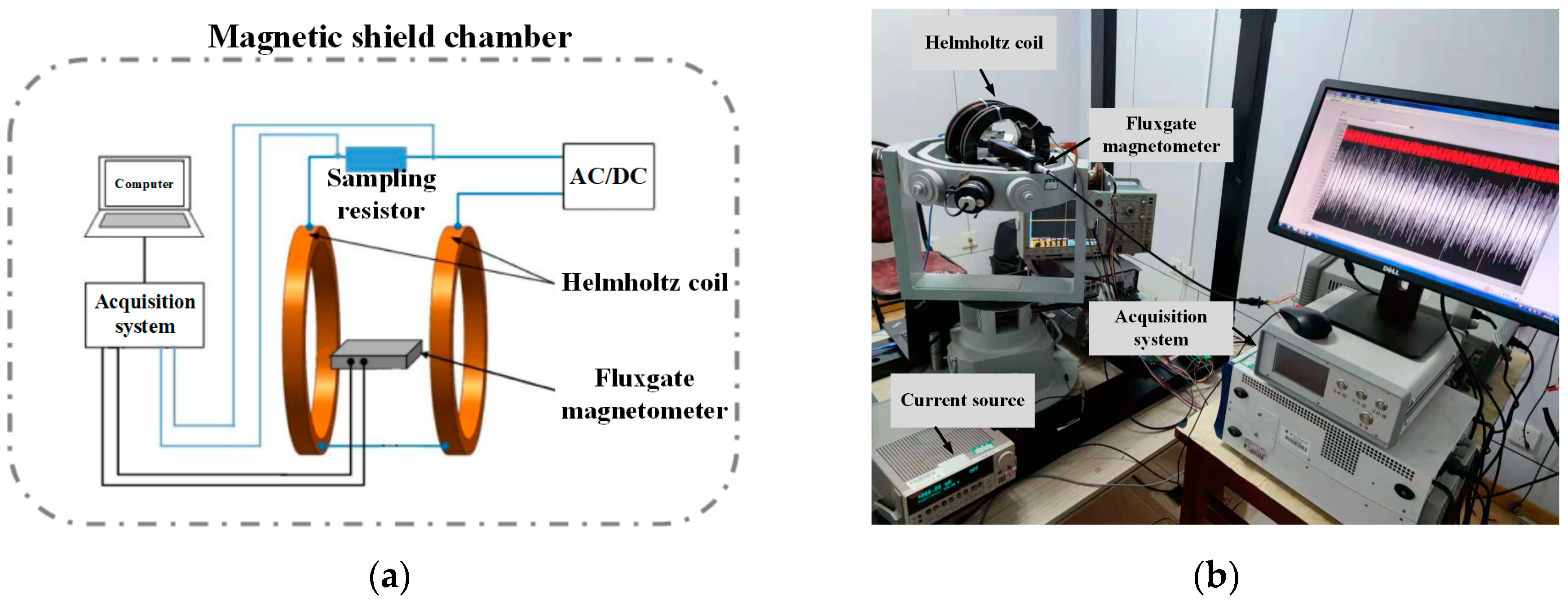
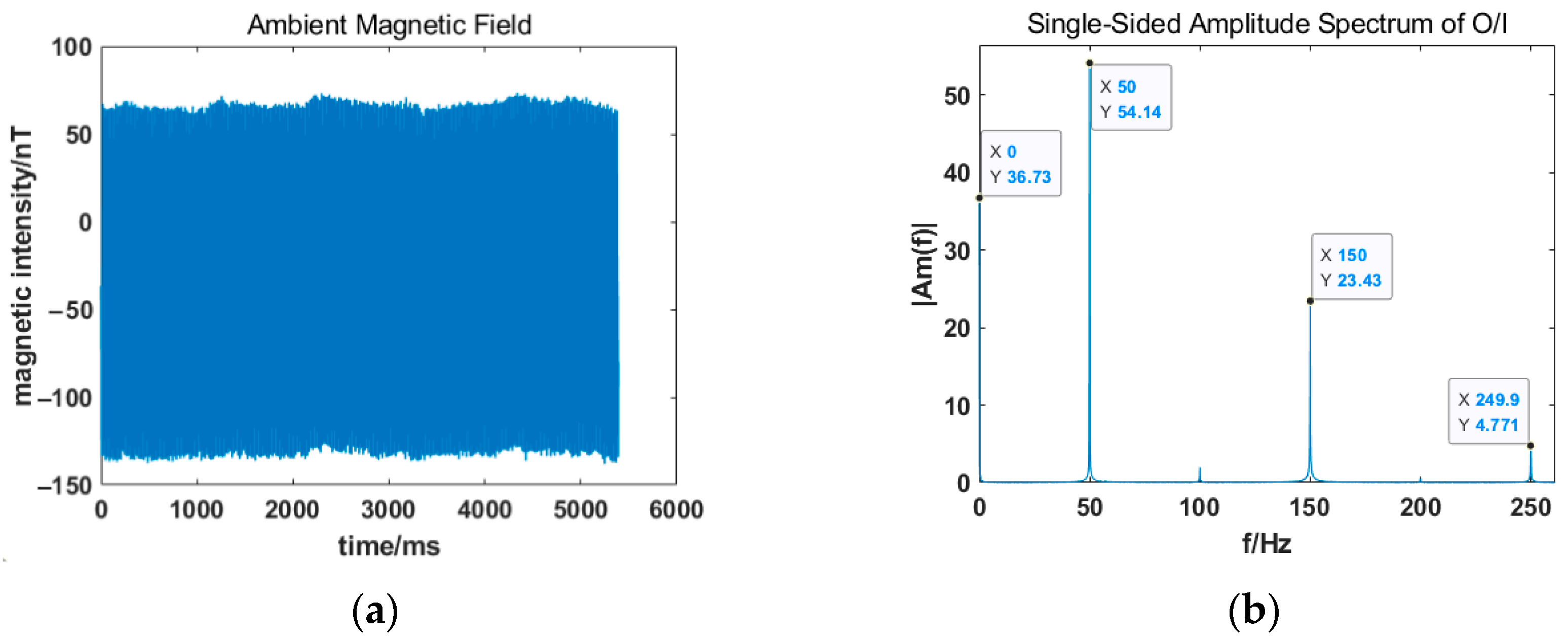
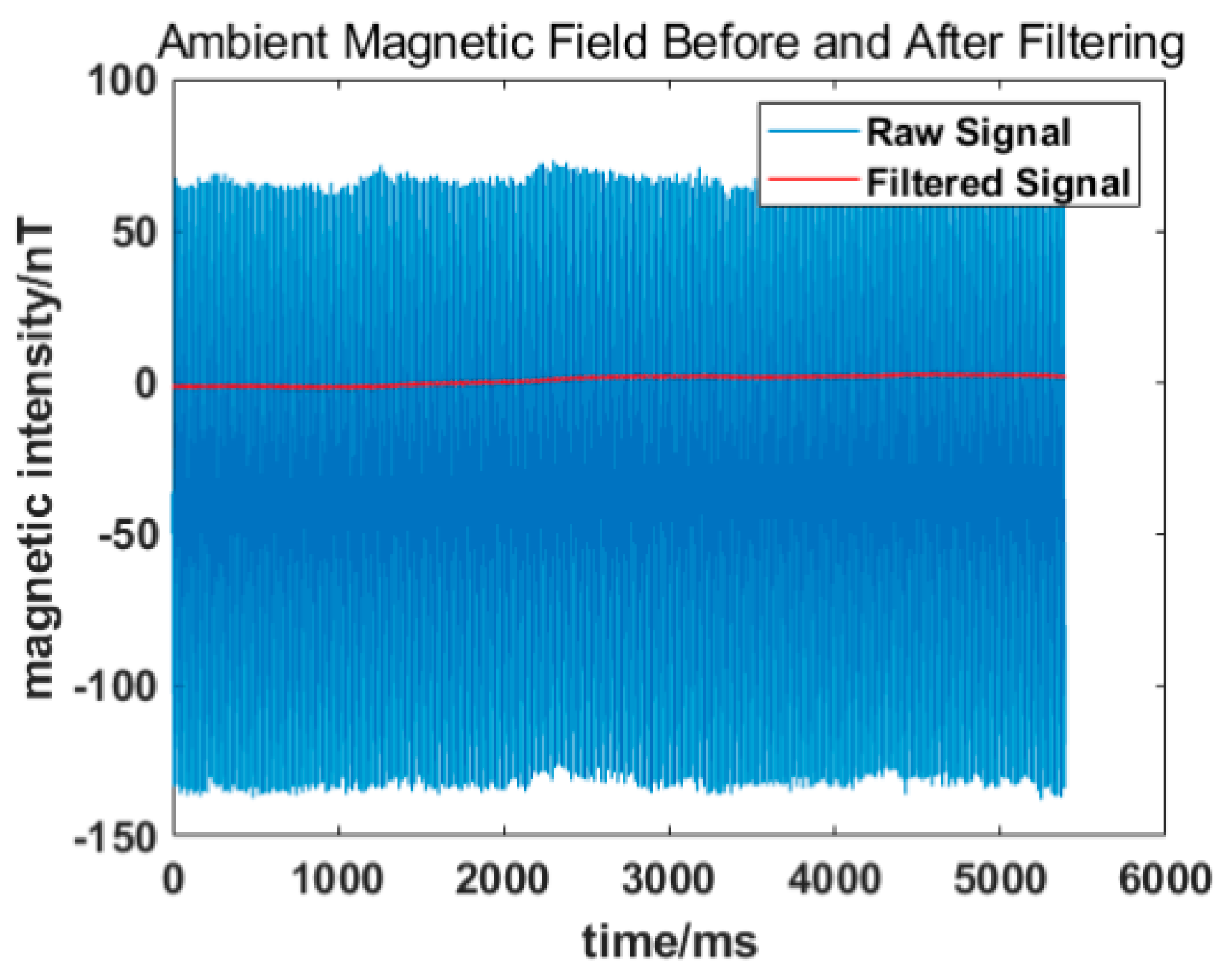
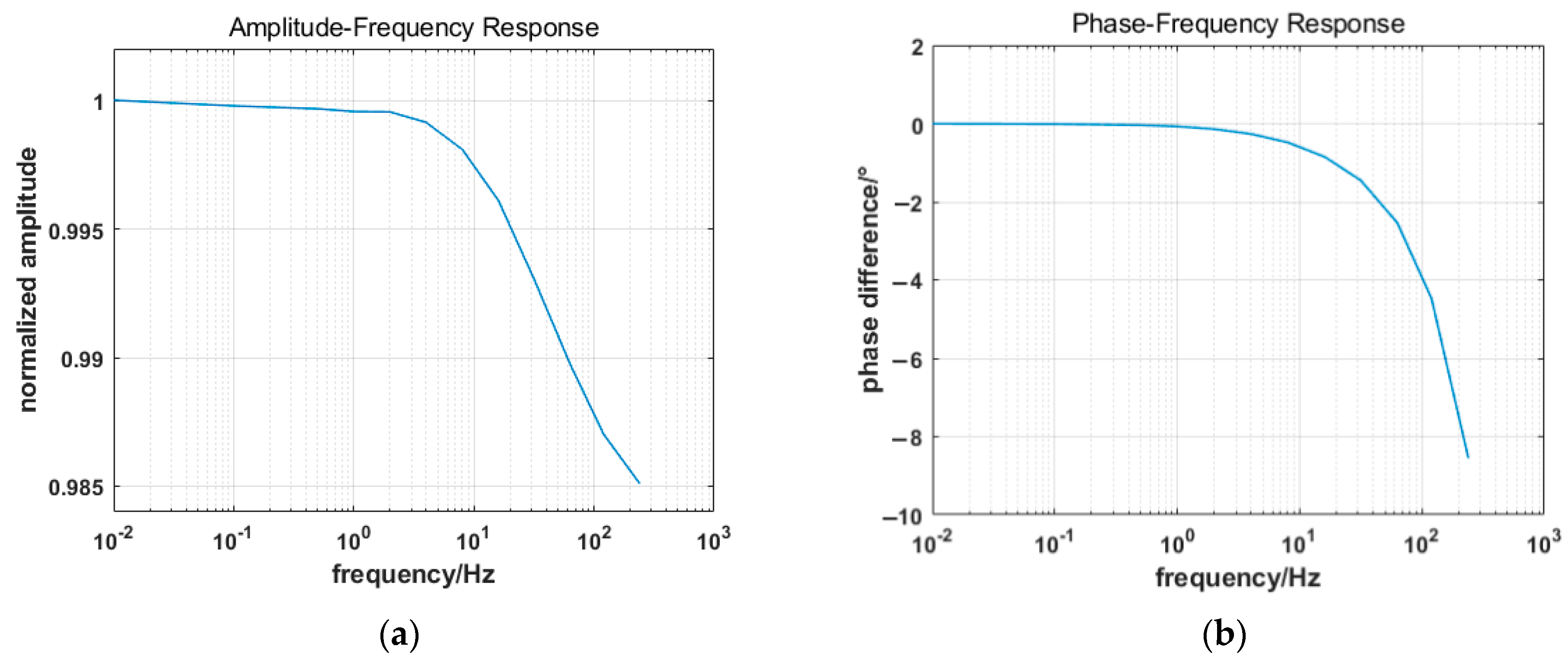

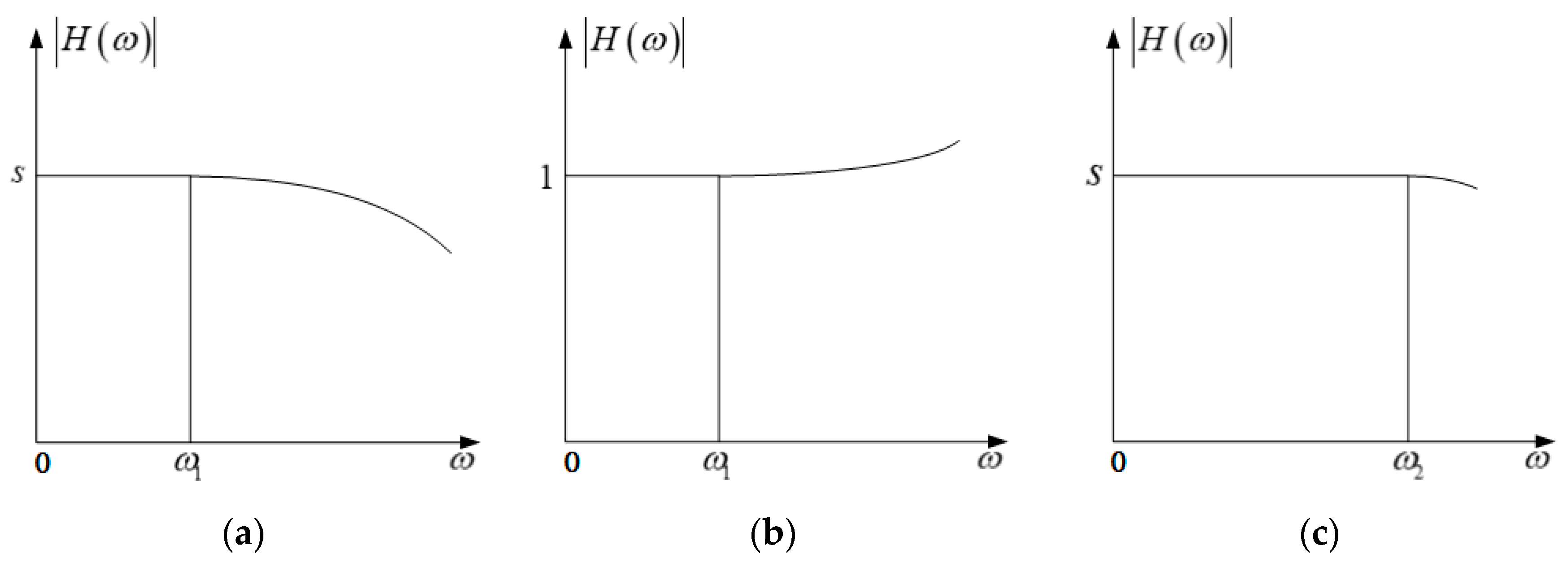
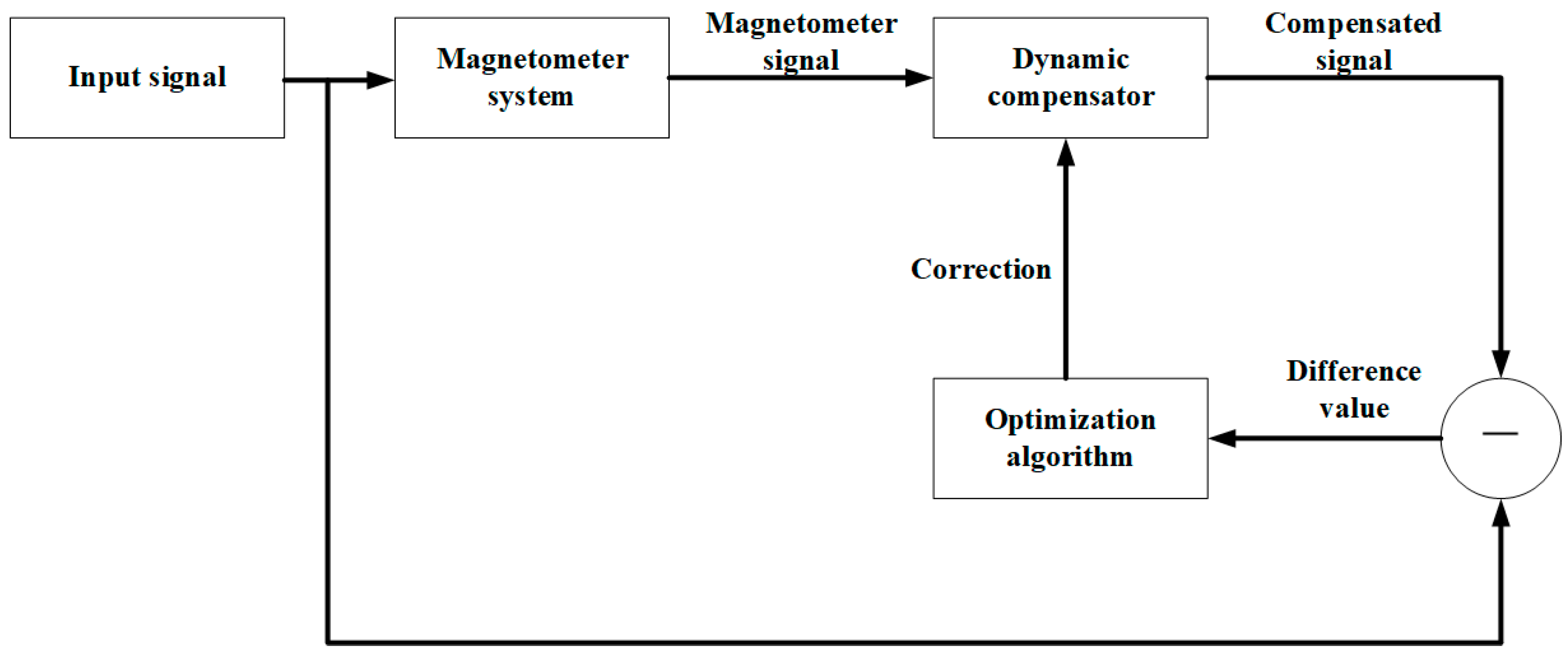
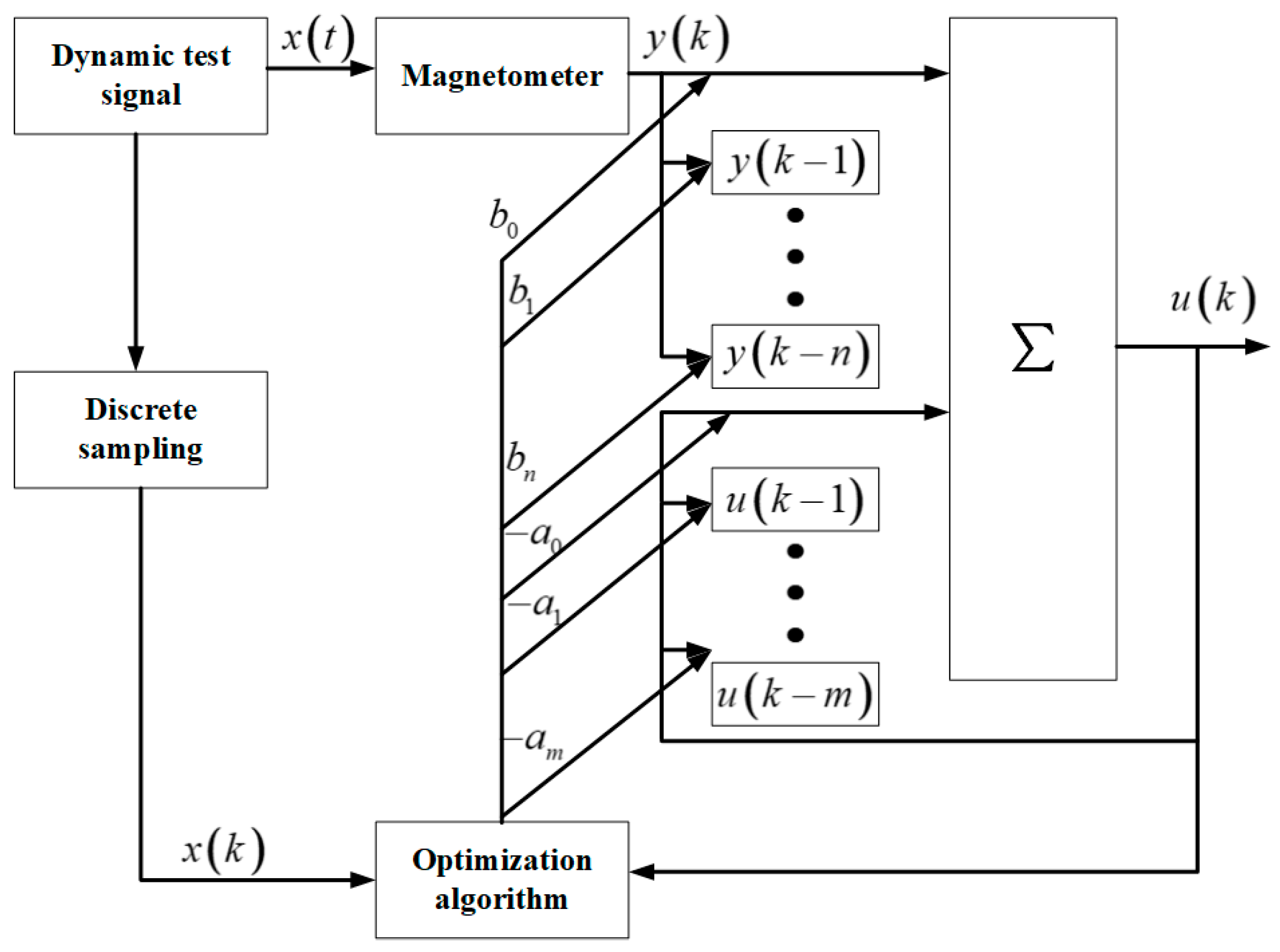
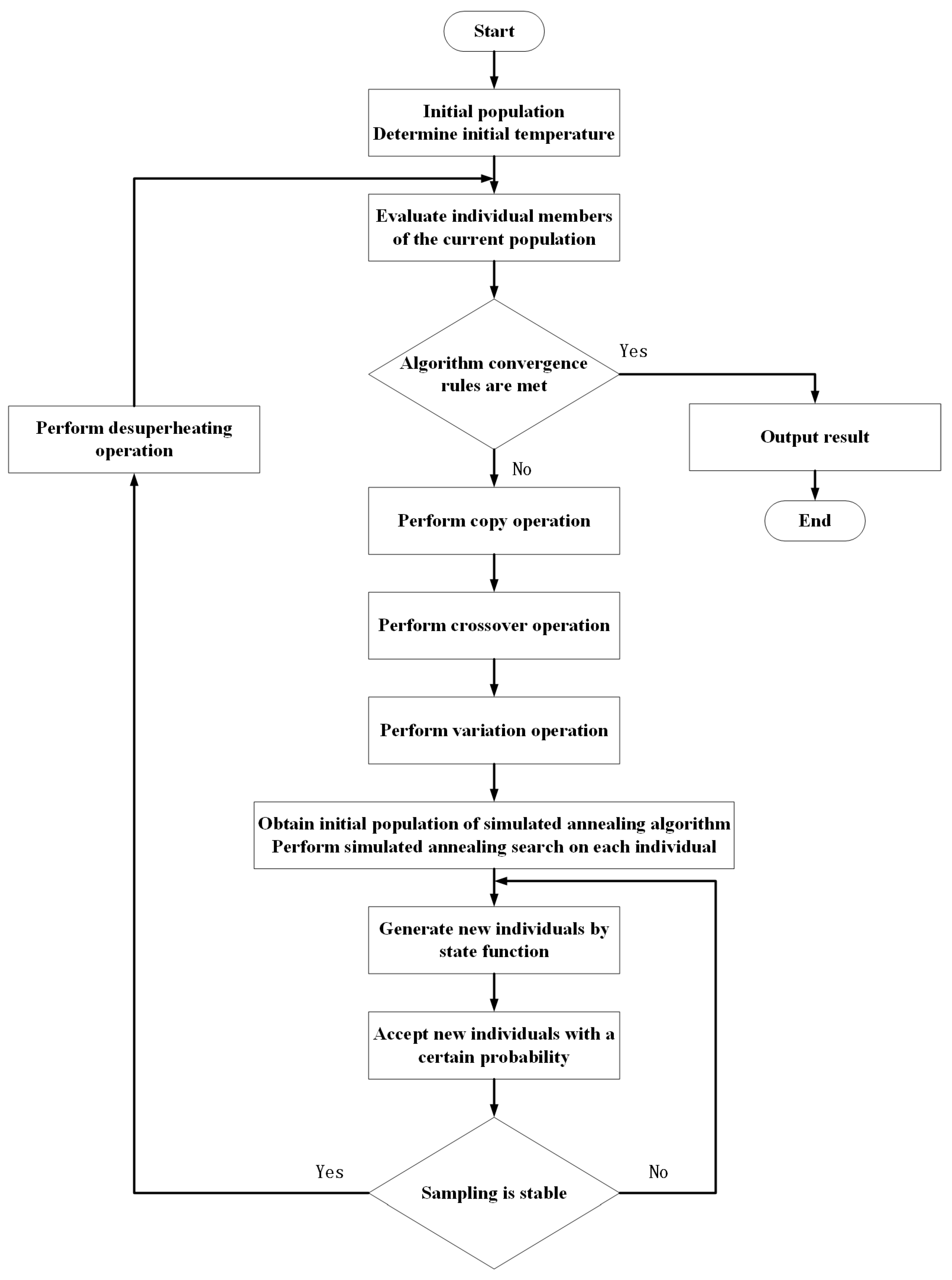
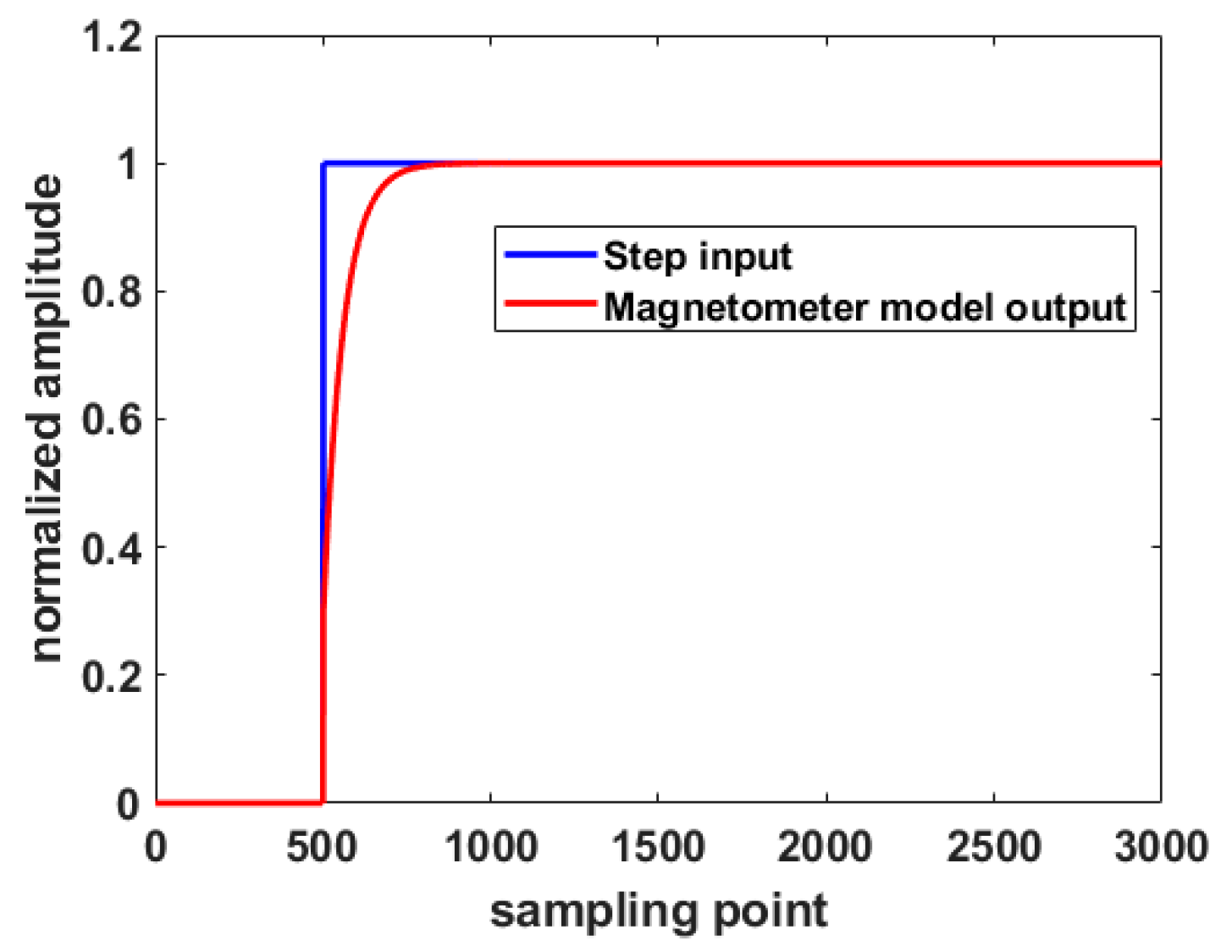
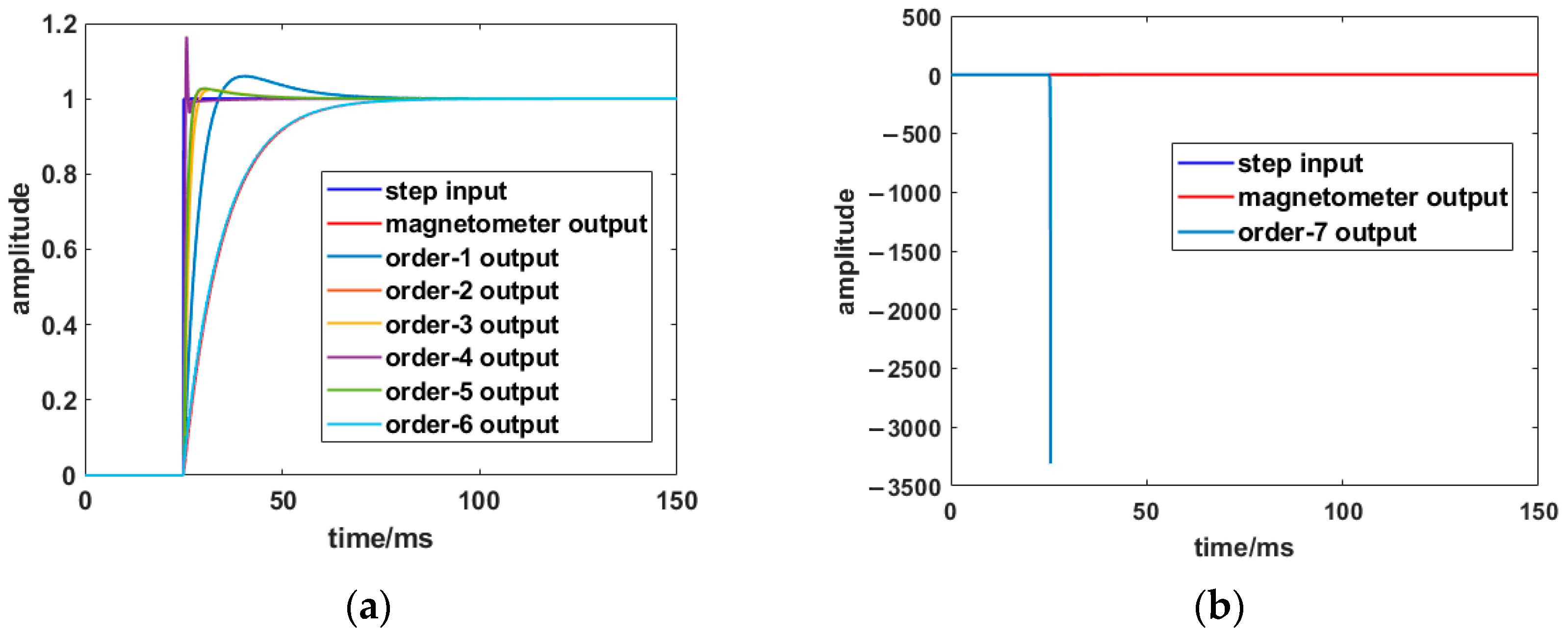
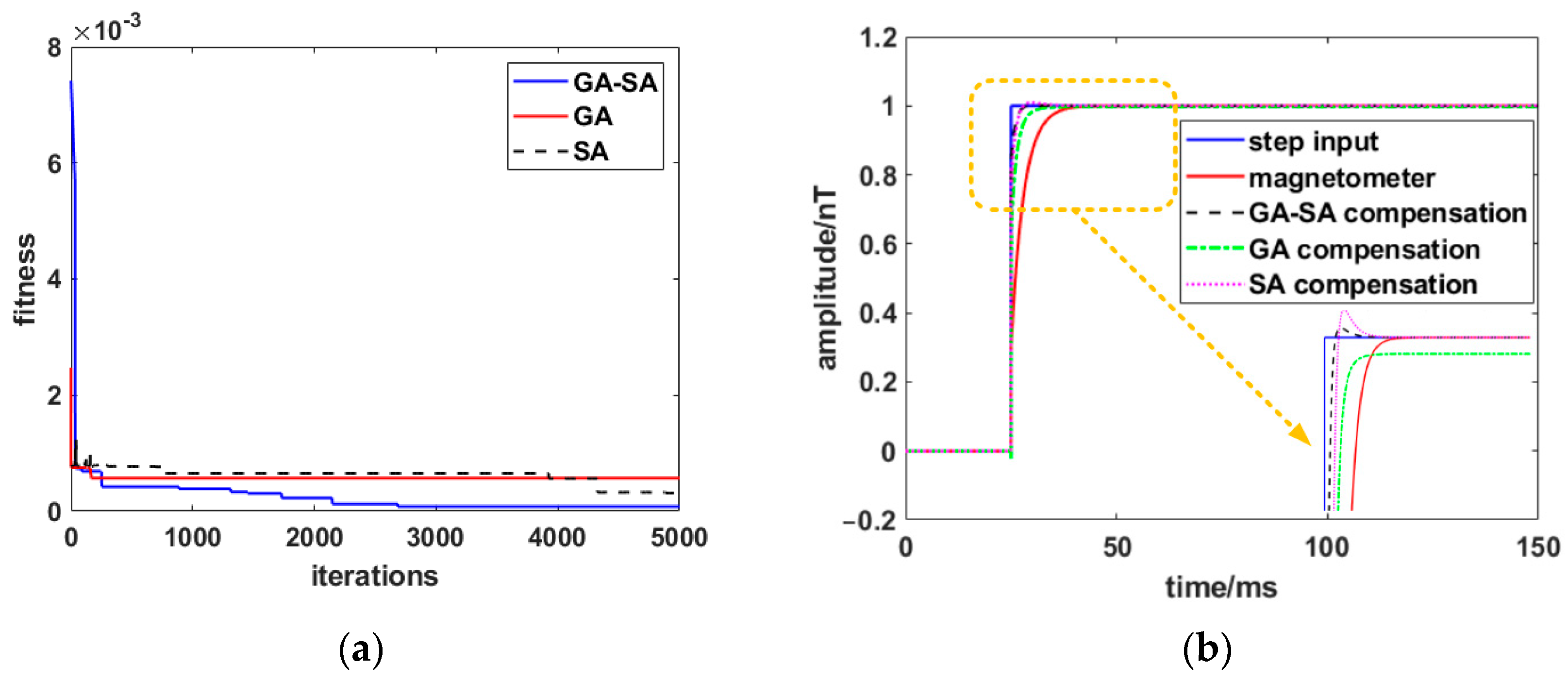
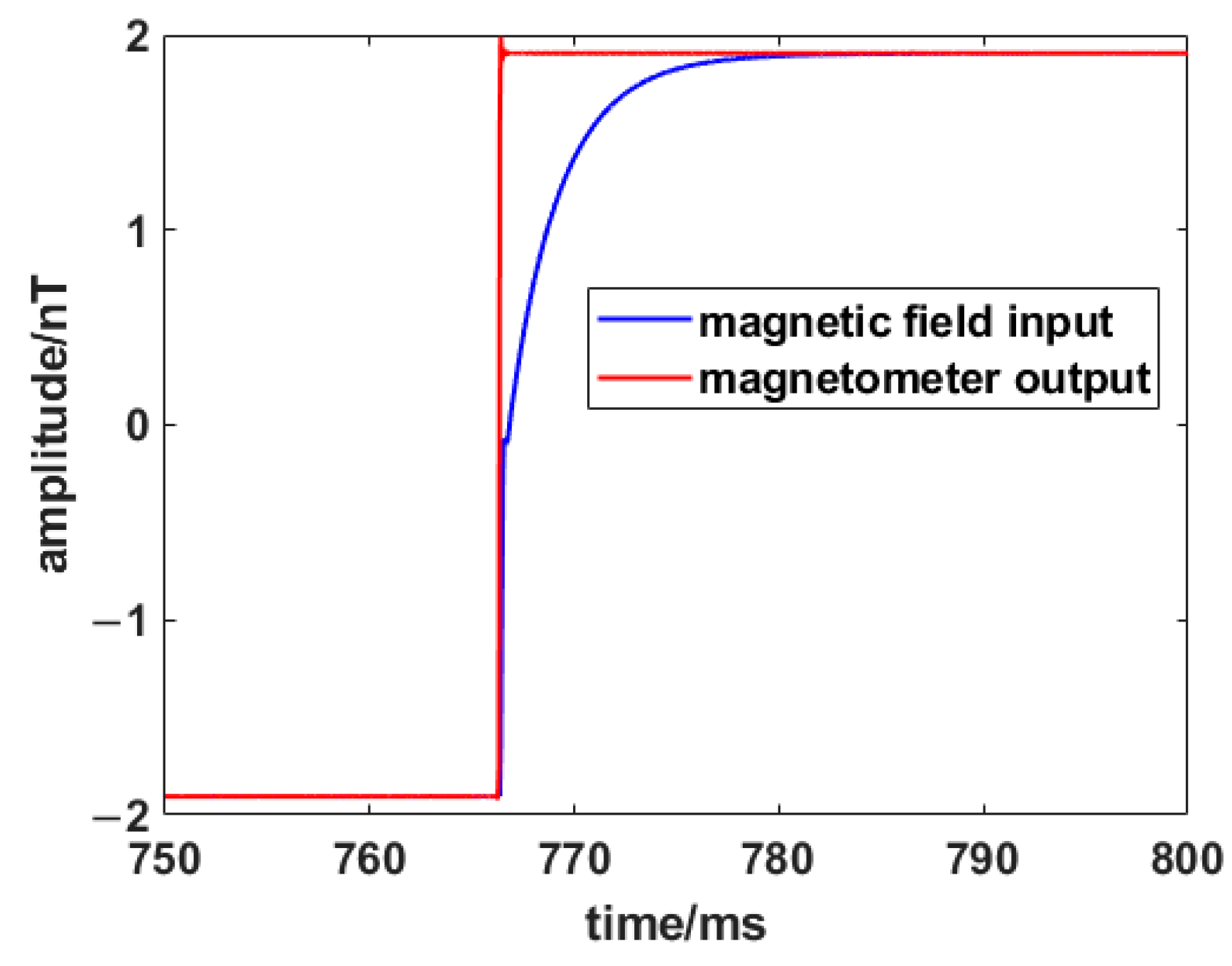
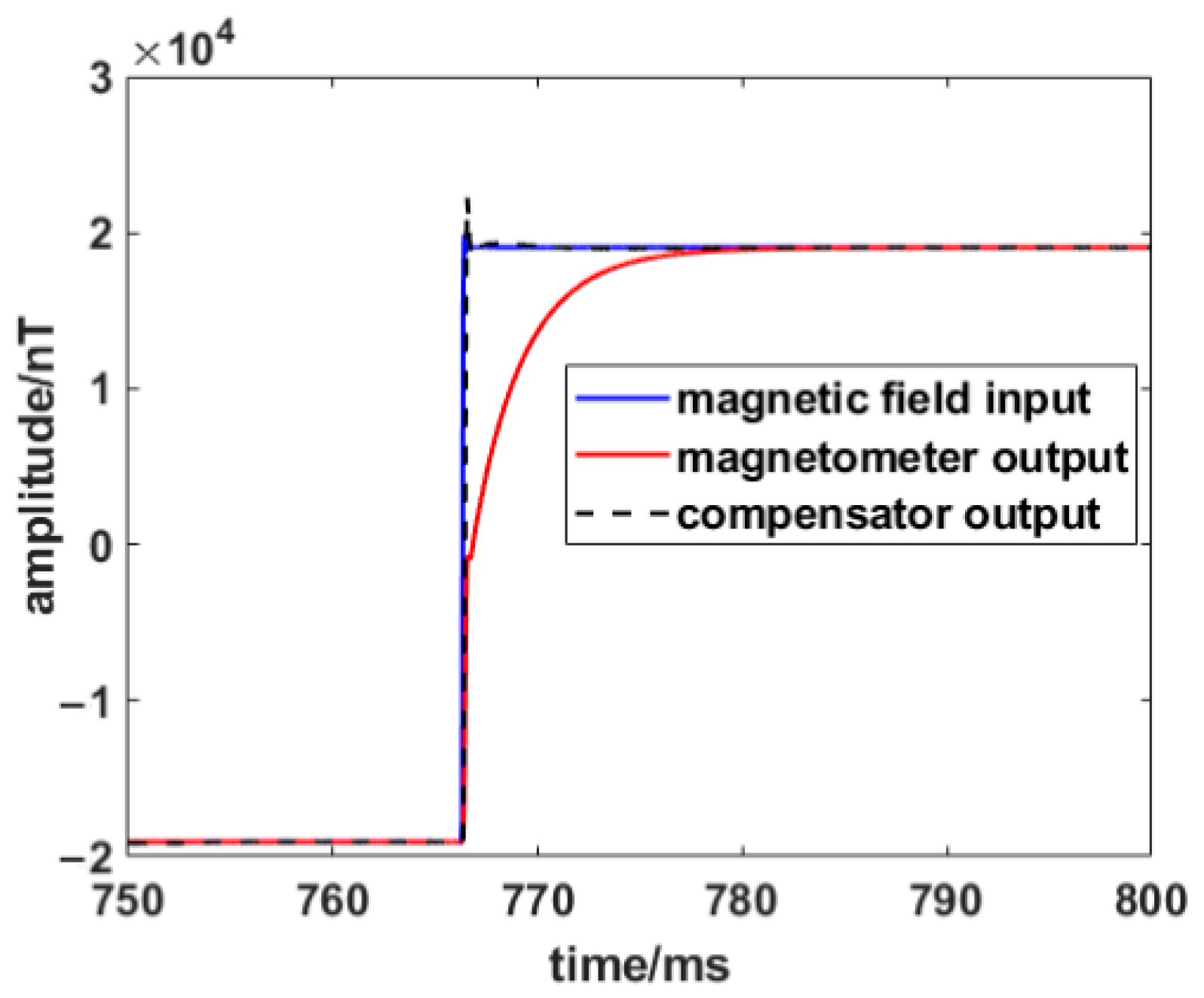
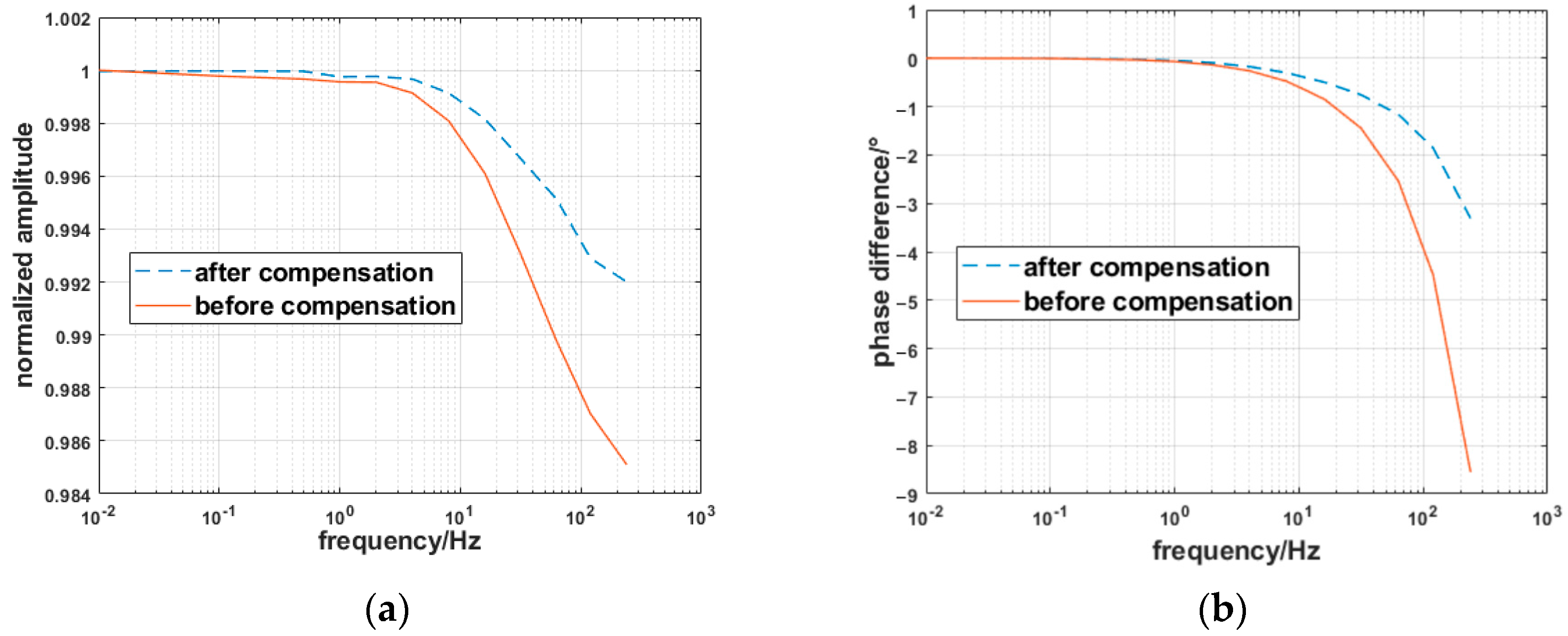
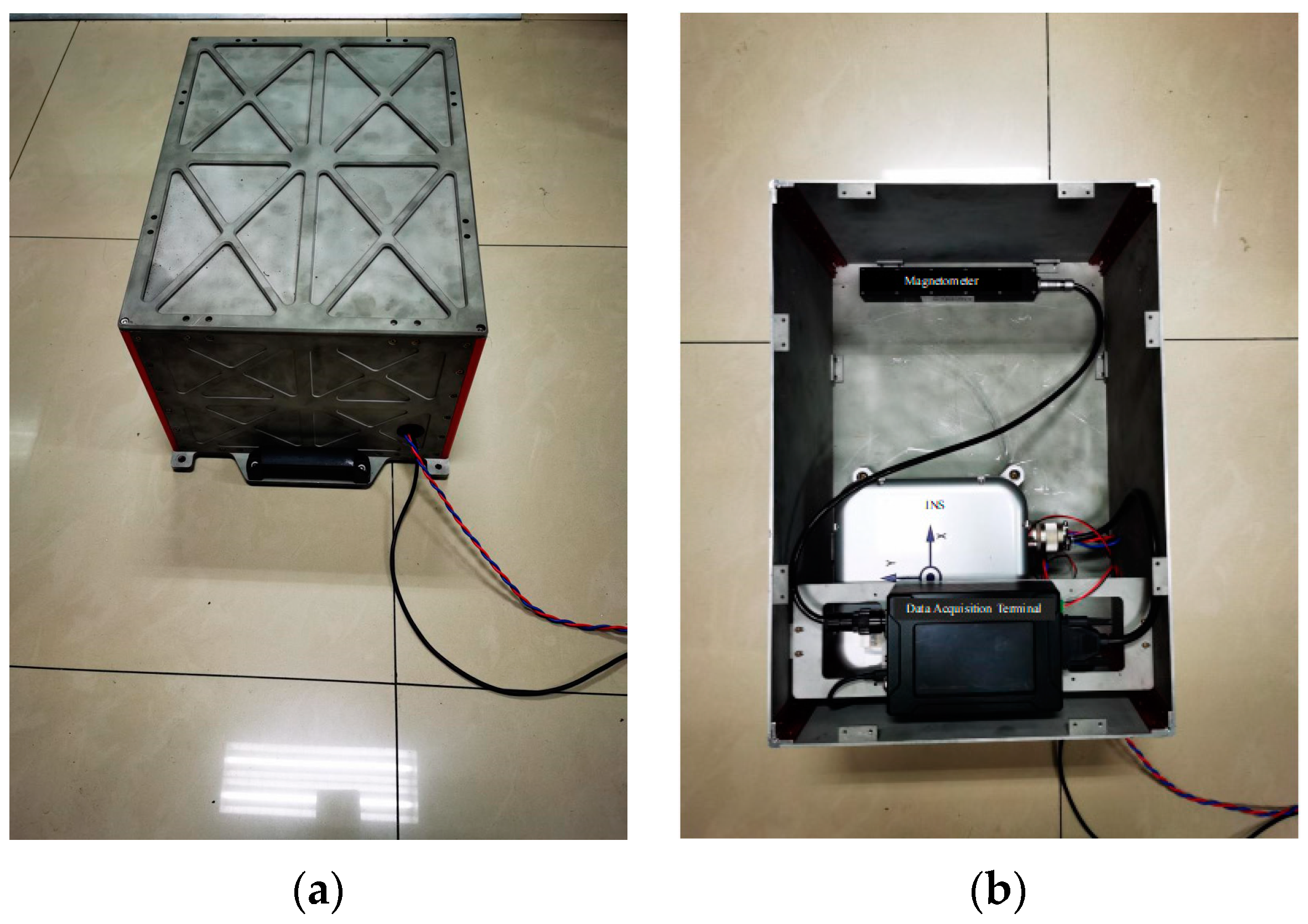
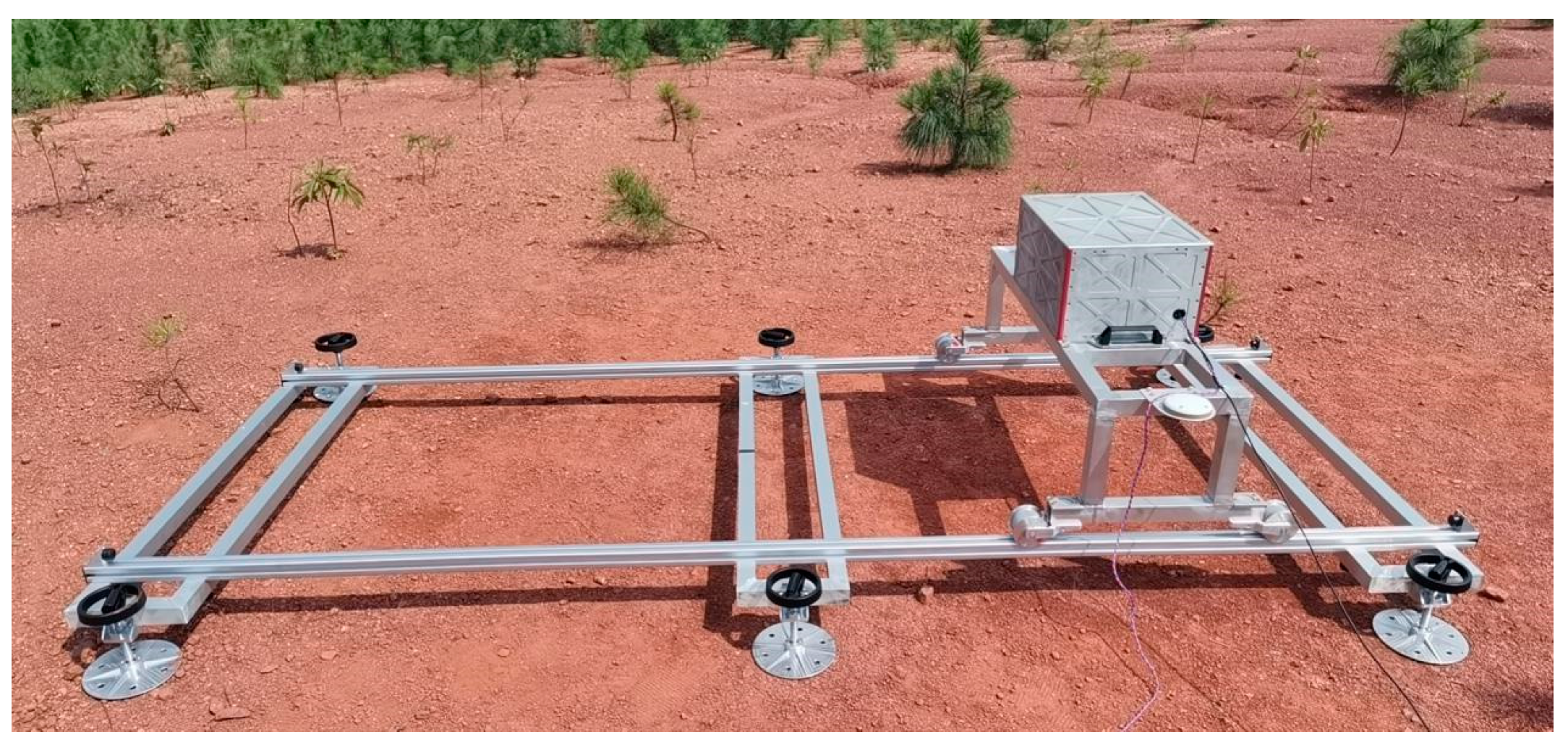

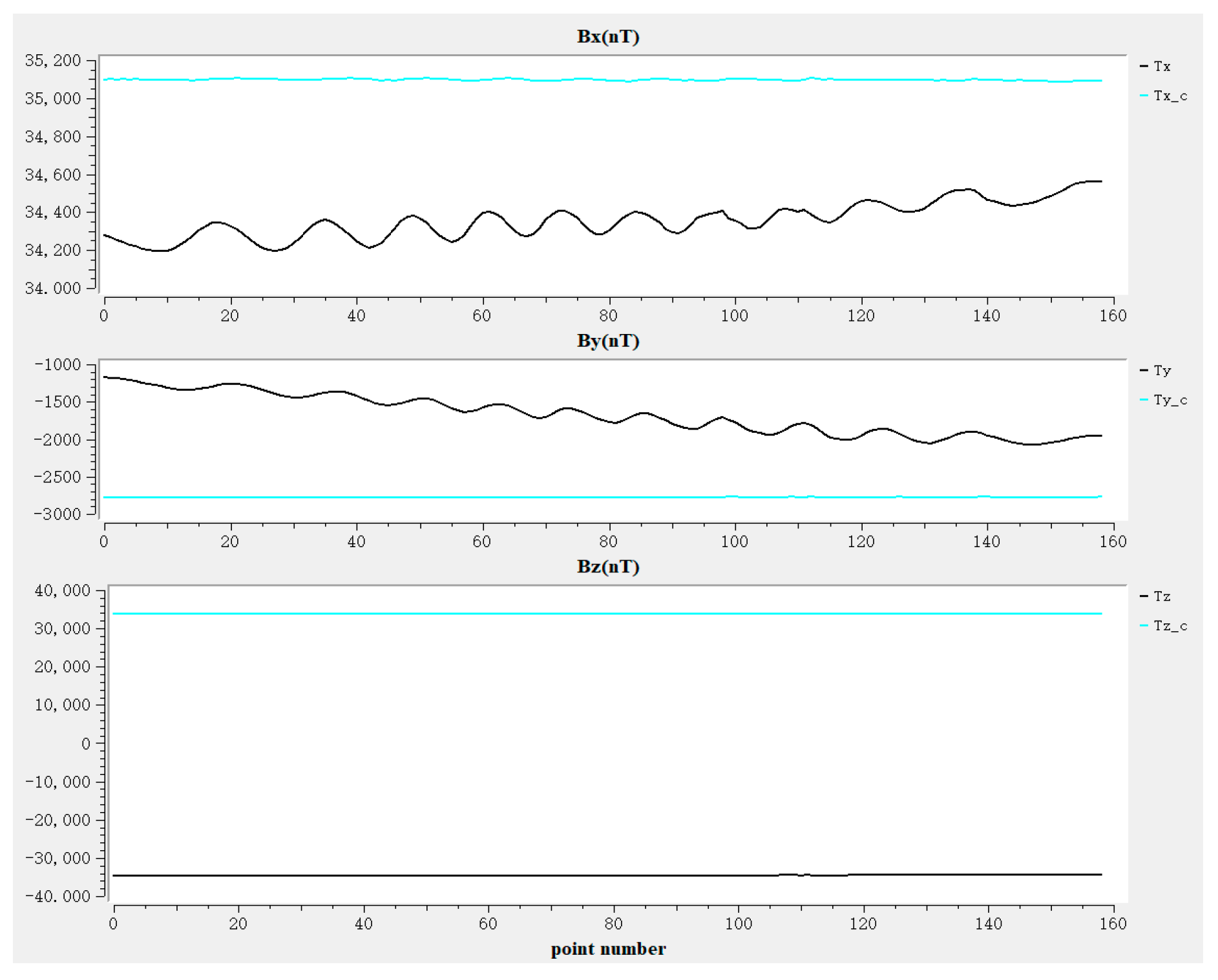

| Ambient Magnetic Field Parameter | Before Filter | After Filter |
|---|---|---|
| Standard deviation/nT | 44.41 | 1.07 |
| Mean value/nT | −36.73 | 0.32 |
| Peak-to-peak value/nT | 215.29 | 9.31 |
| Order | Overshoot/% | Response Time/ms | Fitness |
|---|---|---|---|
| 1 | 0.03 | 3.35 | |
| 2 | 0.27 | 1.95 | |
| 3 | 32.39 | 0.80 | |
| 4 | 62.66 | 6.20 | |
| 5 | 1.11 | 9.40 | |
| 6 | 1.01 | 9.10 | |
| 7 | divergency | ||
| Overshoot/% | Response Time/ms | Fitness | |
|---|---|---|---|
| Before dynamic compensation | ---- | 10.70 | |
| After GA compensation | 0.35 | 4.20 | |
| After SA compensation | 0.92 | 2.10 | |
| After GA-SA compensation | 0.17 | 1.95 |
| Overshoot/% | Response Time/ms | |
|---|---|---|
| Before dynamic compensation | ---- | 10.91 |
| After dynamic compensation | 4.3% | 0.63 |
| Bx | By | Bz | |
|---|---|---|---|
| Calibration value/nT | 35,034.99 | −2819.58 | 34,061.87 |
| Bx | By | Bz | ||
|---|---|---|---|---|
| Standard deviation/nT | Before compensation | 95.30 | 277.35 | 108.51 |
| Static compensation | 62.90 | 107.96 | 79.95 | |
| Dynamic compensation | 3.41 | 2.36 | 2.75 |
Disclaimer/Publisher’s Note: The statements, opinions and data contained in all publications are solely those of the individual author(s) and contributor(s) and not of MDPI and/or the editor(s). MDPI and/or the editor(s) disclaim responsibility for any injury to people or property resulting from any ideas, methods, instructions or products referred to in the content. |
© 2023 by the authors. Licensee MDPI, Basel, Switzerland. This article is an open access article distributed under the terms and conditions of the Creative Commons Attribution (CC BY) license (https://creativecommons.org/licenses/by/4.0/).
Share and Cite
Chen, Z.; Wang, Z.; Zhang, Q.; Liu, Z.; Pan, M.; Chen, D.; Xu, Y. Dynamic Compensation of a Fluxgate Magnetometer Based on a Hybrid Optimizing Algorithm. Appl. Sci. 2023, 13, 2830. https://doi.org/10.3390/app13052830
Chen Z, Wang Z, Zhang Q, Liu Z, Pan M, Chen D, Xu Y. Dynamic Compensation of a Fluxgate Magnetometer Based on a Hybrid Optimizing Algorithm. Applied Sciences. 2023; 13(5):2830. https://doi.org/10.3390/app13052830
Chicago/Turabian StyleChen, Zhuo, Zhenxiong Wang, Qi Zhang, Zhongyan Liu, Mengchun Pan, Dixiang Chen, and Yujing Xu. 2023. "Dynamic Compensation of a Fluxgate Magnetometer Based on a Hybrid Optimizing Algorithm" Applied Sciences 13, no. 5: 2830. https://doi.org/10.3390/app13052830
APA StyleChen, Z., Wang, Z., Zhang, Q., Liu, Z., Pan, M., Chen, D., & Xu, Y. (2023). Dynamic Compensation of a Fluxgate Magnetometer Based on a Hybrid Optimizing Algorithm. Applied Sciences, 13(5), 2830. https://doi.org/10.3390/app13052830






